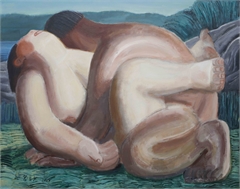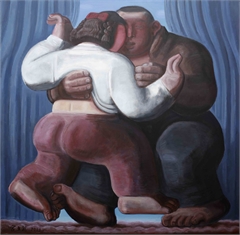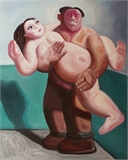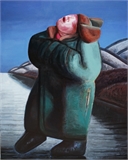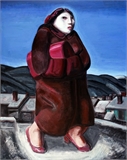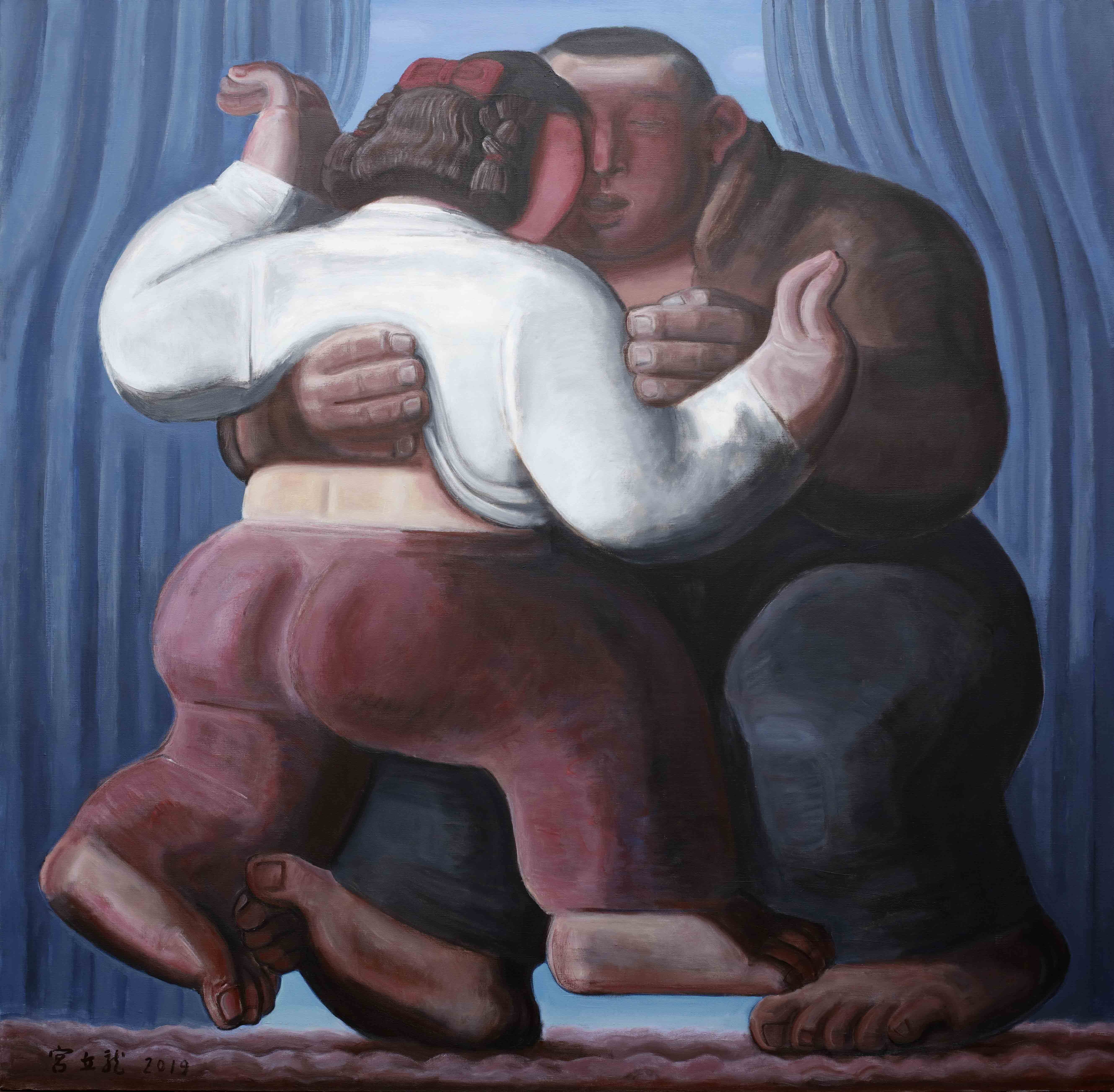
Gong Lilong began his art painting around 1980. He was a student of Class 1977/1978 after the reinstatement of the college entrance examination at the Oil Painting Department of Lu Xun Academy of Fine Arts (LAFA). Amongst the first-generation young college students in the new era, he was so keen on the changes of the times. While approaching and embracing the changes, he was also portraying the ubiquitous newcomers and new things in an arrogant and sarcastic tone. In 1980, he was shortlisted for the 2nd National Youth Art Exhibition as a student candidate with his work, Road (1980) and won the third prize. This fledgling work portrays a dozen young people in distinct styles of clothing in the new era on the group image. Such technique featuring a specific group, a clear motif, and sequential characterization is a bit close to the fresco style that emerged nationwide in the early 1980s. In the painting surface, Gong tried to use the visual strategy of cubism. Take the image of the second human figure from the right as an example. In the painting, the man, wearing a red cap with tape recorder on his hands, looks like a “ruffian”. He wears yellow plaid shirt and fashionable bell-bottoms, as well as a white coat which seems to fall from the body. In the back of his head hides half-face who brushes against him. The contrast between flat and overlapping color blocks and the decorative pattern, combined with the flattening method, sets the tone for the paining; while the plain character of the figure standing rigidly straight causes confusion as if it is felt in the realistic training before 1976.
Starting with this work, Gong ambitiously confronted and communicated with the inherent traditions in the Academy in his early practice. He passed on the idea behind the Path to the oil painting work Street (1982), but more exaggeratedly, he placed 165 figures in various overlapping square spaces, where people are travelling amid various billboards and signs in Chinese and English in the streets in 1980s. The contrast of red, yellow and blue is the main color of the painting. The restlessness and extremely uncomfortable visual perception make it more of a collage than a painting. The artist went further by applying rich and diverse portrait details in the painting, and intentionally or unconsciously, allowing them to express themselves for visual impact, though they still look like facial-makeup. Last is also the anecdote frequently mentioned by the artist: this work which had been shortlisted for the 6th National Exhibition failed to be at the final exhibition as the middle was embedded with a real electronic watch. After painting this work, Gong also created his well-known oil painting work, A Mild Student is Making Herself Up in Front of Mirror for Playing Harlequin A、X、QKE at Weekend Party (1987), in which a model dressed strangely is presented, freed of any modernism technique. The artist adopted extremely realistic techniques to shape the head, hand, face and the skin under the neck of this figure, yet the alignment of edge lines and light-shadow showed a sense of solemnity; in sharp contrast, the model wears strange, “European” style, but simply woven clothes and slightly funny long headscarf with her hands in the air, instilling darkness and rebellion into the painting. Gong deliberately gave the painting a lengthy and meaningless name. "Harlequin" and "A, X, QKE" also seemed to intentionally or unintentionally sneer at people’s high esteem towards classism, including him. It is no wonder that the commentator often quotes the critics Liu Xiaochun's words to describe his style: "seriously cynical and solemnly humorous."
Interestingly, A Mild Student is Making Herself Up in Front of Mirror for Playing Harlequin A、X、QTE at Weekend Party (1987) and its extension Naguan Gūwalgiya is the Bride with Longest Period of Sitting on Blessed Cushion in Phoenix Village (1989) convey more than realistic “anger” and seeming humor. At that time, Gong has not established a specific style of his own, and there were some intriguing connections between him and the sweeping modernist movements and discussions in Beijing and across the country. Such connections were not built in the sense of time. Naturally, the new-generation artists and art groups represented by the “85 New Wave” went against the academy. These artists who joined or were grouped into this with academic background had seen the changes in cultural context as compared to that for the first-generation college students in the new era. In the mid-1980s, academic publishing and discussion around “Western learning” and “traditional Chinese learning” shaped the “cultural zeal” amongst publications such as “Into the Future”, “Culture: China and the World”, and “The 20th Century Library”, and institutional advocators such as the “Chinese Culture Institute”. Inspired by such environment, many of the new-generation artists had developed a broad understanding of art through extensive reading and discussions of western modernist culture and art. In the opposite of rigid academy education, such understanding covers not only diversified and free painting techniques, but also a mix of modern knowledge and dogmas from the West. “Cultural zeal”, a natural gene for “85 New Wave”, inspired the philosophical, aesthetic and social works in terms of human existence and consciousness, religion and rationality, humanistic spirit and secular society. The academy has been eclipsed in the narrative of art history at that time and even later. Artists of varying ages working in the academy bridged the art traditions from socialism period and even from the Republic of China, which had been long shaped and obscured respectively by dogmatic academy education. For most of them, including young artists growing in the mid-1980s like Gong, the “realism” of the new era remained an unavoidable subject. It is inevitable to look for the possibility of connecting the outside of the academy within the realism, whether as Markov said, "Realism is infinite", or by incorporating the scar art in the late 1970s. Gong employed the classical technique to shape the part of the imagery, and modernist visual strategies for conception design while leveraging the philosophical focus on human existence in the context of “cultural zeal”. This was not groundbreaking, but nurtured a force beyond clear description at that time.
In spite of his absence from the Beijing-centered modernist art movement, Gong was inevitably enveloped by it at that historical moment. In 1987, he was exploring the “classical realism" while the critics pointed out the conflict between classical style and modernist style at several national art exhibitions. A special seminar was then held by the Art magazine on 13 Feb 1988 in Beijing, for discussing the conflict between "pseudo" classical style and "pseudo" modernism, which resulted from the mature "85 New Wave" movement. In essence, the practitioners of the two styles of painting or "pseudo" styles were also members of this art movement, who used “pseudo" to refer to each other so as to voice their own artistic faiths. Such reflection and fresh understanding on the “85 New Waves” revealed the belief that modernism was not necessarily the winner and classical realism could still occupy a place, and also showed the anxiety about the tension between the artistic language itself and the times. In the 18th issue of Art News of China in 1988, the article Process of Purification invited by the critic Li Xianting and written by Meng Luding was published, where the artist Meng made clear the need for “language purification” of art. Meanwhile, Li’s work, The Times Yearns for Passion of Big Souls, was also published on the same magazine. In comparison, the former spoke for thinking about the issue of art from within, while the latter emphasized on the individual strength and moral responsibility inspired by the west-east culture clash by art. As said by Meng, “In today’s modern Chinese painting, the unity between language and sense may be overlooked as we attach more attention on deepening senses. The emergence of any new art calls for artists with the intuitive experience and rational mastery of the culture in its totality, and the capacity of transforming such experience into perfect and unique visual language.” Instead of challenging the complex interaction between individuals and cultural context stressed by Li, this notion also found its way back into an old question, namely form VS content under the influence of thinking within the realist framework. For Gong, an artist growing in the 1980s, he also proposed a common concern: whether the old form of realism could survive the ever-changing times and inspire the emergence of individuality.
Based on such concern, Gong's works in the 1980s shared a strong sense of metaphor in terms of spirituality under the framework of realism. Focusing on the appearance and essence of reality, he often radically presented the targeted image in an extreme way of expression, which enhanced realism even to the extent of grotesque, thus strengthening the metaphor of the works. His efforts to integrate social and cultural elements with art were made to continue exploring the old subject of “reproduction" and “expression” after Mr. Zhao Dajun (1939-) and Xu Rongchu (1934-), the pioneering graduates of LAFA. After the 1990s, especially after 1992, however, Gong changed his idea.
Gong joined the second oil painting technique research class of French surrealism painter Claude Yvel held by LAFA in 1991. The first session of this class had sparked in 1988 discussions about oil painting materials and techniques. Aside from the artist's artistic achievements, Gong’s research and modernization on the ancient European classical oil painting techniques and materials won the praise from the art colleagues in the Chinese academies. Yet as recalled by himself, Gong was aware of the complexity of classical techniques from this class and quitted the thought of continuing this, due to failure to identify any communication path between such technique and the contemporary spirit. Later, he produced the oil painting Chun Xiu Sending Spring Festival Couplets to Gou Zhu’s Home on the 29th Day of the 12th Month in the Lunar Calendar (1992), marking a fresh change in his painting career. The whole oil painting focuses on “Chun Xiu”, a lovely and kind rural girl with shaking ponytail. With reference to some painting language of Andrew Wyeth, the artist caught a sacred (secular?) moment and directly instilled his explicit emotions into the solitary girl on the green and serene field. This girl “wearing a rosy jacket goes uphill and downhill swiftly with a warm smile”1. “Her right hand holding the cotton jacket on the chest”, “heavy ponytail and solid neck”, “benign face”, “half-closed eyes", and the "slightly curved mouth" were all caught in the artist’s eyes of excitement and exhilaration. Such work unveiled the artist’s expectations of simple beauty, mixed with holiness and desire. Seemingly, they have bid farewell to the indescribable void and obscure complex shrouded by the morality and majesty of realism.
This work was also presented in the "Guangzhou Biennale" curated by Lü Peng in 1992, and won the award and the recognition from the invited critics nationwide. Interestingly, Gong, who used to appear in the official art exhibition system, chose to take part in this non-governmental “Biennale" featuring contemporary consciousness and art marketization with this transitional work. Together with the Village Head (1994) and the Sister-in-law (1994), the work represented Gong’s shift towards contemporary art. They all centered on the full-length portrait of figure and took inspiration of roundness and geometric sense of the pottery figurine in the Qin and Han Dynasties. Following the difficult transformation from 1989 to 1992, the artist began to gradually focus on the figure portraits. Less well-known is that in the late 1980s, he also tried to draw a large number of watercolor portraits in the form of "classical realism", some of which were used for classroom teaching, and some were even complied into the teaching materials of watercolor painting. These works, such as the Costume Designer (1989) and the Lotus(1990), were self-trainings of the artist on figure portrait. By applying the brushwork details involving painting knives, these works contained some expressiveness and modernist elements, which also led to the transformation of the artist.
Noteworthy, from Chun Xiu Sending Spring Festival Couplets to Gou Zhu’s Home on the 29th Day of the 12th Month in the Lunar Calendar (Chun Xiu)tothe Village Head, Gong shook off the emotional illusion. His poetic sense made “Chun Xiu” slightly sweet and romantic. In contrast, he depicted the rough and common village head in full figure symbolically, highlighting the completeness of the shape and removing the slender and too soft parts of the line. Since then, Gong's contemporary method has been shaped. He has also radically practiced this style and visual strategy for the next two or three decades.
However, this new approach changed again during the “First Critics Nomination Exhibition” in 1994. This exhibition presented an array of works with realistic themes and expressive creation techniques. Gong's four oil paintings were exhibited, two of which were called Modern Steps (1994) and Play Billiards (1994). Both works and the New Wave (1993) have inherited the purity strategy that Gong began to establish in 1992. This strategy was a result of thinking of creators in the academy, and also a trend of Chinese modern and contemporary art separated from the enlightenment of the 1980s. Specially, Gong was more concerned about the so-called “spirituality” in these works. Without expounding its connotation, he intended to maintain a rational care and thinking in the face of these characters with distinct social attributes and rich individuality, and present his thinking by means of a technique close to “conceptualism”, which reminded us that “’85 New Wave” was also a “Northern Art Group” originating from the Northeast. They also used “rationality” as an ultimate appeal, and attempted to express their yearning for individuality through the broad concept of “rationality” or even by abstracting this concept lacking cultural context at that time. For Gong, he did not come into contact with the group that later left the Northeast for South and practiced its declaration in a more conceptual way. But they can be said to be consistent in the sense of the pursuit for individuality.
Despite these non-portrait paintings adopted Gong’s new figure depiction methods, they were focused on the daily life of the Northeastern countryside. To incorporate some narrative and social factors into the painting surface with local culture, Gong designed the clothing, postures, movements, psychology, and activities of figures in these painting from original rural life, though some of narratives were made up by the artist. Based on this fact, it is understandable that critics usually comment on the attention on the regional characteristics of the Northeast and China's disadvantaged rural culture during the transition period in these artworks by Gong. Gong welcomed such comments. He was also thinking about how to prevent his social care from being reduced into a simple historical progressivism and how to get rid of formalized and rigid rural narratives in the socialist period.
From the early 1990s, artists who live and work in the northeast of China, centering on LAFA, are starting to be known to the public. The young critics Gu Zhenqing and Yang Li put forward a new concept named "LAFA Phenomenon" though an article they post on Jiangsu Art Monthly In June 1992, thinking that “it refers to an unique art orientation and appearance formed by the artists from LAFA since The 1989,as well as the special art state they immersed.”Firstly, in LAFA, western classical style is still very popular. And the academy’s realistic skills, production level and the perfection of painting language are completely enough to compete with international academic status. However, many painters tend to be confined to the ivory tower of pure art, obsessed with the art academic value, and have less attention to the reality, which weakens the practical pertinence of art. Secondly, the diversified art pattern of LAFA has not been fully developed, and gradually forming the realistic art of being left alone. The academic environment of "LAFA" where the artists studding at are relatively closed, which makes them disjointed from the modern and contemporary art activities in places like Beijing. Because of being at this disjointed environment, they can obtain more sufficient and comfortable space to develop this realism tradition. Since the mid-1980s ,their works have appeared frequently in official art exhibitions, which is quite different from places like Beijing where artists confront at the authorities in art practice.
In recent twenty years, there were several large-scale presentation and combing of "LAFA" and even to the northeast contemporary art development. In 1993, Gu Zhenqing and Yang li curated "Northeast Contemporary Oil Painting Exhibition" in liaoning Art Museum. In 1994,"The First Critic Nomination Exhibition"was held in National Art Museum Of China (NAMOC), and the selected new works from several young and middle-aged northeast painters like Jia Difei, Gong Lilong, Wang Yigang and Wei Ershen had the opportunity to be in the spotlight. More than ten years later, in 2005, "LAFA" held "LAFA Oil Painting Department Teacher Works Exhibition", which summarized the inheritance and transformation of "LAFA Phenomenon” since entering into the 21st century. In 2006, the exhibition "From‘Polar Region’ to ‘Tie Xi Qu’---Exhibition of Contemporary Art in Northeast China(1985—2006)" curated by Wang Huangsheng, Guo Xiaoyan and Dong Bingfeng was held in Guangdong Museum of Art, trying to position the territory of northeast China in art history.
Gong has never avoided speaking up that he is obsessed with the secular mind, roughness and sense of drama characteristic of countryside life. There are so many sensitive aspects in his personality, and it shows in a persistent way of seeking the facts. For example, in terms of form, he prefers static and heroic shapes and conversations rather than the forms of impressionism which are characterized by the capture of fleeting and poetic color dynamics. In his work Work in the Fields (1993),he painted a cow and a man seem to be completely out of the context of the times. One man and one cow stand tall in the picture, with a kind of idolatrous, vigorous (although the farmer who leads the cow in the picture is a woman) and timeless expression causing a absolutely shocking effect. He tends to be serious about details of rural life, or as some critics are often mentioned, the "mannequins", hoping the audience will pay close attention to the match of the tie and cotton-padded jacket on the village head, and the pair of semi-old liberator shoes slipped on Chun Xiu’s feet, as well as the light and shadow details of many portraits' faces he made. At the same time, he is also teasing the audience's eyes in this way .Because with the gaze like that, the country life is becoming a strange and odd object of curiosity, and Gong secretly challenges both of the hierarchical consciousness and cultural limitations in the eyes of viewers.
From the perspective of the art criticism environment, it continues the cultural concern in the 1980s, the art criticism in the 1990s is still filled with cultural anxiety. In the cultural field, many critics and writers focused on the tension between elites and secularism, art criticism and commercialism, as well as the west and Chinese mainland.They discussed and argued about "pop art", "gaudy art" and other paradigms of visual art in this scope. All this inevitably formed a strong voice, which affected many artists' work and turned it into a dialogue in the certain timeliness. Gong's work in the 1990s did not avoid this dialogue. He regarded the countryside as a place to test and criticize the changes and essence of secular life. Thanks to the conversion into dialectical unity of solemnness and desire, elegance and gaudiness from specific life that can be felt and seen, we can sense which direction an artist is marching toward in his pursuit of serious art: seeking a balance between general thinking and concrete forms. In other words, this is so much like his beloved painter Balthus (Balthasar Klossowski, 1908-2001).
Entering the 21st century, Gong returned to the portrait themes again and created a wide range of dual-character portrait paintings which were highly recognizable, and thoroughly digested the heaviness and deliberately constructed absurdity in his works of the 1990s,.He highlighted human desire. In these portraits, the two characters tend to be presented in the shape of a holistic sculpture, that is, they form an integral whole. Two closely connected dancing persons make various types of exaggerated body movements. This compositions method can be said that it exaggerates some elements of the realistic techniques: the hands and feet are obviously enlarged, which makes people think of the widely praised work Muscleman (1977) from "LAFA" artist Zhao Dajun who shapes muscles in plaster statue with a defamiliarized and geometric format. Gong, in technique, continues the combination of knife and pen as expressed in his portrait works in the 1990s. The combination of hard-edged abstraction representing the texture of clothes, and the simple movement of figure edges, is presented very skillfully. Compared with coloring, although Gong pays much attention to the shaping , we can still see it is growing brighter and easier.In these double portraits, Gong continues to place the figures in the foreground with a strong visual impact, while the background still serves just as a simple reminder. Artist Wang Xingwei, a student of Gong, sensitively notices his teacher's compositions of visual space during this period: In his early works, Gong often processes the image in a two and a half dimensional space, with both the stereo shaping and compression on three dimensional space, which is a bit like high relief, a sculptural relief between the relief and the round. The highlighted main character is embedded in the background, which has strong material sense and presses forward to the surface, to limit the three dimensional attribute of the main subject, so that the image planarity could be emphasized. "This is the pattern of image processing which is followed in the early Renaissance and modern times by many painters including Cezanne and Balthus. It is almost a creed, a taboo, and a political correctness.
Gong's works in this period gradually stepped out of the questioning of cultural conflicts. Step by step, Gong crystallized the image of his drawing objects and focused on persons. However, instead of unclassifiable individuals possessing absolute personalities, persons in his paintings are dynamic images that are defined by a certain relationship and can be shaped and interpreted by viewers. He loves to repeat depiction of strong emotion and sex appeal included in love, with loose or tight brushwork and low or high emotions, he spreads out his feelings about "Desire for food and sex is natural" in his painting. Characters in his paintings dancing pleasurably in the middle of nowhere, sometimes completely lose their respective identity, with the obscurity of identity, culture and region, and the odd fashion collocations of characters, it becomes more and more hard to divide them. Gong seems to be immersed in the joy of discovering himself in this schematism, and changed his focus from abstract “spirituality” to real persons with a sexual relationship. Following the shift from countryside to context-free unknowns, Gong abandoned the pattern carrying cultural symbolism and turned to more distinctive practices.
In recent years, there have been some new changes under the theme of double portraits. For example, in Mountain and Boys Love Girls (2017), the characters seem to be more comfy and relaxed, which conveys Gong's mood when entering this stage of life. In works such as Wish People for a Long Time (2014)Hero Twilight Years (2016), the sense of movement starts to disappear. He uses more casual brushwork to depict people's love and snuggling, which reappears the solemn feeling and beckons to his compositions in the 1990s.The characters here are no longer the passionate, jovial, blood-transparent people, but a reflection of the artist’s looking at his inner self and asking about the relationship between the ego and the others.
Around 2012, after a long time painting double portraits, Gong went back to single portraits painting, which was once started in 1990s.The long practice had enabled the artist to depict a stereo portrait, reflecting the object from its emotional, modal, psychological and situational dimensions. Most of these works were finished in acrylic. In Brother Yuan (2013-2018), Zi Que (2018), and other works, we see the artist no longer demanding in concrete problem of representation, such as the planarity of the space, the sweet and calm of the edge line. He looked at these seemingly disproportionate figures with warmth, with more gentle strokes, a less sculpted look, and a consistent emotional engagement. Like Zi Que, it describes the appearance of a woman who is a migrant worker, walking on the way back to her home village, with her hands in her pockets. In order to maintain a sexy posture, she must wipe white foundation, bare her ankles and wear purple high-heeled shoes, however, has to walk with her legs bent in the winter night. Gong referred to her as "the Madonna", in which there was no discrimination in the eyes, but the awareness of their difficulty and empathy for their hardship.
In another work, Soft Summer (2017), Gong made up a forest scene in which two nude figures lie cuddled, without too much detail or sense of relief. This seems to herald a new direction of work. Artist Gong Lilong says he will take his summary of different modalities as "Lang (unrestrained), Yao (enchanted), Wu (shamanistic), Chang (steady), Biao (rash)", with "nature, spirituality, divinity, steadiness, relaxation", and "fascinating seducing, provocating, attracting, dazing" to generalize these single portrait images he depicted, by which he transforms the spiritual depth and humanistic inspiration drawn from Giotto, Wyeth and Balthus into contemporary painting practice.

